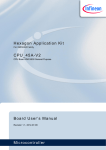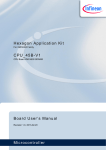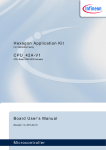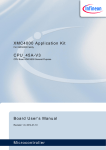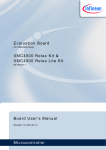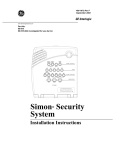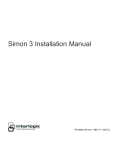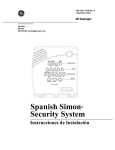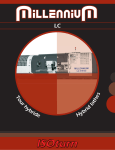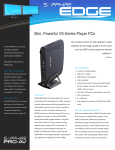Download Microcontroller Hexagon Application Kit Board User„s Manual
Transcript
He xa gon Applic atio n Ki t For XMC4000 Family CP U_ 45 A - V2 CPU Board XMC4500 General Purpose Boa rd Us er„s Ma nu al Revision 1.0, 2012-02-28 Mic rocon t rolle r Edition 2012-02-28 Published by Infineon Technologies AG 81726 Munich, Germany © 2012 Infineon Technologies AG All Rights Reserved. Legal Disclaimer The information given in this document shall in no event be regarded as a guarantee of conditions or characteristics. With respect to any examples or hints given herein, any typical values stated herein and/or any information regarding the application of the device, Infineon Technologies hereby disclaims any and all warranties and liabilities of any kind, including without limitation, warranties of non-infringement of intellectual property rights of any third party. Information For further information on technology, delivery terms and conditions and prices, please contact the nearest Infineon Technologies Office (www.infineon.com). Warnings Due to technical requirements, components may contain dangerous substances. For information on the types in question, please contact the nearest Infineon Technologies Office. Infineon Technologies components may be used in life-support devices or systems only with the express written approval of Infineon Technologies, if a failure of such components can reasonably be expected to cause the failure of that life-support device or system or to affect the safety or effectiveness of that device or system. Life support devices or systems are intended to be implanted in the human body or to support and/or maintain and sustain and/or protect human life. If they fail, it is reasonable to assume that the health of the user or other persons may be endangered. CPU_45A-V2 CPU Board XMC4500 General Purpose Revision History Page or Item Subjects (major changes since previous revision) Revision 1.0, 2012-02-28 Initial release Trademarks of Infineon Technologies AG AURIX™, C166™, CanPAK™, CIPOS™, CIPURSE™, EconoPACK™, CoolMOS™, CoolSET™, CORECONTROL™, CROSSAVE™, DAVE™, EasyPIM™, EconoBRIDGE™, EconoDUAL™, EconoPIM™, EiceDRIVER™, eupec™, FCOS™, HITFET™, HybridPACK™, I²RF™, ISOFACE™, IsoPACK™, MIPAQ™, ModSTACK™, my-d™, NovalithIC™, OptiMOS™, ORIGA™, PRIMARION™, PrimePACK™, PrimeSTACK™, PRO-SIL™, PROFET™, RASIC™, ReverSave™, SatRIC™, SIEGET™, SINDRION™, SIPMOS™, SmartLEWIS™, SOLID FLASH™, TEMPFET™, thinQ!™, TRENCHSTOP™, TriCore™. Other Trademarks Advance Design System™ (ADS) of Agilent Technologies, AMBA™, ARM™, MULTI-ICE™, KEIL™, PRIMECELL™, REALVIEW™, THUMB™, µVision™ of ARM Limited, UK. AUTOSAR™ is licensed by AUTOSAR development partnership. Bluetooth™ of Bluetooth SIG Inc. CAT-iq™ of DECT Forum. COLOSSUS™, FirstGPS™ of Trimble Navigation Ltd. EMV™ of EMVCo, LLC (Visa Holdings Inc.). EPCOS™ of Epcos AG. FLEXGO™ of Microsoft Corporation. FlexRay™ is licensed by FlexRay Consortium. HYPERTERMINAL™ of Hilgraeve Incorporated. IEC™ of Commission Electrotechnique Internationale. IrDA™ of Infrared Data Association Corporation. ISO™ of INTERNATIONAL ORGANIZATION FOR STANDARDIZATION. MATLAB™ of MathWorks, Inc. MAXIM™ of Maxim Integrated Products, Inc. MICROTEC™, NUCLEUS™ of Mentor Graphics Corporation. Mifare™ of NXP. MIPI™ of MIPI Alliance, Inc. MIPS™ of MIPS Technologies, Inc., USA. muRata™ of MURATA MANUFACTURING CO., MICROWAVE OFFICE™ (MWO) of Applied Wave Research Inc., OmniVision™ of OmniVision Technologies, Inc. Openwave™ Openwave Systems Inc. RED HAT™ Red Hat, Inc. RFMD™ RF Micro Devices, Inc. SIRIUS™ of Sirius Satellite Radio Inc. SOLARIS™ of Sun Microsystems, Inc. SPANSION™ of Spansion LLC Ltd. Symbian™ of Symbian Software Limited. TAIYO YUDEN™ of Taiyo Yuden Co. TEAKLITE™ of CEVA, Inc. TEKTRONIX™ of Tektronix Inc. TOKO™ of TOKO KABUSHIKI KAISHA TA. UNIX™ of X/Open Company Limited. VERILOG™, PALLADIUM™ of Cadence Design Systems, Inc. VLYNQ™ of Texas Instruments Incorporated. VXWORKS™, WIND RIVER™ of WIND RIVER SYSTEMS, INC. ZETEX™ of Diodes Zetex Limited. Last Trademarks Update 2011-02-24 Template: IFX_Template_2011-02-24.dot CPU_45A-V2 CPU Board XMC4500 General Purpose Table of Contents Table of Contents 1 1.1 1.2 Overview ............................................................................................................................................. 7 Key Features ........................................................................................................................................ 7 Block Diagram ...................................................................................................................................... 8 2 2.1 2.2 2.3 2.4 2.5 2.5.1 2.5.2 2.5.3 2.6 2.7 2.8 2.9 2.10 2.11 2.11.1 2.11.2 2.11.3 Hardware Description ........................................................................................................................ 9 Power Supply ....................................................................................................................................... 9 Reset .................................................................................................................................................. 11 Clock Generation................................................................................................................................ 12 Boot Option ........................................................................................................................................ 12 Debug Interface .................................................................................................................................. 13 Cortex Debug Connector (10-pin) ...................................................................................................... 14 Cortex Debug+ETM Connector (20-pin) ............................................................................................ 15 DriveMonitor2 Connector ................................................................................................................... 16 Serial Flash Memory .......................................................................................................................... 17 USB .................................................................................................................................................... 18 RTC .................................................................................................................................................... 19 LED .................................................................................................................................................... 20 Potentiometer ..................................................................................................................................... 20 Satellite Connectors ........................................................................................................................... 20 COM Connector ................................................................................................................................. 21 HMI Connector ................................................................................................................................... 22 ACT Satellite Connector ..................................................................................................................... 22 3 3.1 3.2 3.3 Production Data................................................................................................................................ 23 Schematics ......................................................................................................................................... 23 Layout and Geometry ......................................................................................................................... 27 Bill of Material ..................................................................................................................................... 28 Board User's Manual 4 Revision 1.0, 2012-02-28 CPU_45A-V2 CPU Board XMC4500 General Purpose List of Figures List of Figures Figure 1 Figure 2 Figure 3 Figure 4 Figure 5 Figure 6 Figure 7 Figure 8 Figure 9 Figure 10 Figure 11 Figure 12 Figure 13 Figure 14 Figure 15 Figure 16 Figure 17 Figure 18 Figure 19 Figure 20 Figure 21 Figure 22 Figure 23 Figure 24 Figure 25 Figure 26 Figure 27 Figure 28 Figure 29 CPU_45A-V2 Board Block Diagram..................................................................................................... 8 CPU Board XMC4500 General Purpose (CPU_45A-V2)..................................................................... 9 Powering option through USB interface (5 V) ...................................................................................... 9 CPU_45A-V2 Board Power ................................................................................................................ 10 Battery (VBAT Supply) ....................................................................................................................... 10 Reset .................................................................................................................................................. 11 Reset LED and Reset Switch ............................................................................................................. 11 Clock Generation................................................................................................................................ 12 Boot Options Switch ........................................................................................................................... 12 Boot Strap Signal Switching ............................................................................................................... 13 Cortex Debug Connector (10-pin) ...................................................................................................... 14 Cortex Debug Connector (10-pin) Layout .......................................................................................... 14 Cortex Debug+ETM Connector (20-pin) ............................................................................................ 15 Cortex Debug+ETM Connector (20-pin) Layout ................................................................................ 16 6-Pin Connector ................................................................................................................................. 16 DriveMonitor2 Connector ................................................................................................................... 17 Quad SPI Flash Interface ................................................................................................................... 17 USB Connector .................................................................................................................................. 18 USB power generation - Host/OTG mode ......................................................................................... 19 RTC .................................................................................................................................................... 19 GPIO LED .......................................................................................................................................... 20 Satellite Connectors ........................................................................................................................... 21 Satellite Connector Type COM .......................................................................................................... 21 Satellite Connector Type HMI ............................................................................................................ 22 Satellite Connector Type ACT ............................................................................................................ 22 Satellite Connectors, USB-OTG......................................................................................................... 24 XMC4500 ........................................................................................................................................... 25 Power, Debug..................................................................................................................................... 26 CPU_45A-V2 Board Layout ............................................................................................................... 27 Board User's Manual 5 Revision 1.0, 2012-02-28 CPU_45A-V2 CPU Board XMC4500 General Purpose List of Tables List of Tables Table 1 Table 2 Table 3 Table 4 Table 5 Table 6 Table 7 Table 8 Table 9 Table 10 Power status LED‟s ............................................................................................................................ 10 Power Measurement .......................................................................................................................... 11 Boot Options Settings ........................................................................................................................ 12 Cortex Debug Connector (10 Pin) ...................................................................................................... 14 Cortex Debug+ETM Connector (20 Pin) ............................................................................................ 15 6-pin Connector .................................................................................................................................. 16 Quad SPI Signals ............................................................................................................................... 17 USB micro AB connector Pinout ........................................................................................................ 18 GPIO LED .......................................................................................................................................... 20 CPU_45A-V2 Board BOM .................................................................................................................. 28 Board User's Manual 6 Revision 1.0, 2012-02-28 CPU_45A-V2 CPU Board XMC4500 General Purpose Overview Introduction This document describes the features and hardware details of the CPU Board XMC4500 General Purpose (CPU_45A-V2) designed to work with Infineon‟s XMC4500 Microcontroller. This board is part of Infineon‟s Hexagon Application Kits. 1 Overview The CPU_45A-V2 board houses the XMC4500 Microcontroller and three satellite connectors (HMI, COM, ACT) for application expansion. The board along with satellite cards (e.g. HMI_OLED-V1, COM_ETH-V1, AUT_ISOV1 boards) demonstrates the capabilities of XMC4500. The main use case for this board is to demonstrate the generic features of XMC4500 device including toolchain. The focus is safe operation under evaluation conditions. The board is not cost optimized and cannot be seen as reference design. 1.1 Key Features The CPU_45A-V2 board is equipped with following features ® XMC4500 (ARM Cortex™-M4) Microcontoller, LQFP-144 Connection to XMC4500 satellite cards via satellite connectors COM, HMI and ACT USB OTG Host/Device support via micro USB connector Debug options − Cortex Debug connector 10-pin (0.05”) − Cortex Debug+ETM connector 20-pin (0.05”) − DriveMonitor2 Stick connector Reset push button 32MBit quad SPI flash memory Boot from Embedded Flash, UART or CAN Ready for power consumption analysis 5 LED‟s 3 Power indicating LED‟s 1 GPIO (P3.9) LED 1 RESET LED Potentiometer, connected to analog input P14.1 Power supply − Via micro USB connector in USB device mode − Via satellite connector pins (COM/ACT satellites cards can supply power to CPU board) − RTC backup battery Board User's Manual 7 Revision 1.0, 2012-02-28 CPU_45A-V2 CPU Board XMC4500 General Purpose Overview 1.2 Block Diagram Figure 1 shows the block diagram of the CPU_45A-V2 board. There are following building blocks: Drive Monitor2 ETH P3.9 XMC4500 LQFP144 ETH CAN CAN2 EE U0C1 2xCS LED TS U2C1 U0C1 4xCS SDMMC U1C0 QSPI CCU 4/8 DRIVER POSIF ENCODER DSD DSMOD DAC OPAMP ADC SENSOR POTI EE SPI 2xISOFACE ERR GPIO GPIO GPIO I2C I2S SPI GPIO SD SPI TS I2C_IOEX GPIO GPIO ERR ERR GPIO GPIO ACT FPGA USB U0C0 RMII COM CAN CPU Board XMC4500 General Purpose CPU_45A-V2 LED JTAG GPIO dir USB OTG JTAG SWV SWD RS485 CAN1 BSL UART CAN SWV SWD UART CAN CAN Debug+ETM 20pin Debug 10pin I2C I2C I2C_IOEX HMI I2C_IOEX reset OLED HEADSET cmd SDCARD TOUCH Figure 1 CPU_45A-V2 Board Block Diagram Board User's Manual 8 Revision 1.0, 2012-02-28 CPU_45A-V2 CPU Board XMC4500 General Purpose Hardware Description 2 Hardware Description The following sections give a detailed description of the hardware and how it can be used. Micro-AB USB Connector Power LEDs ACT Satellite Connector COM Satellite Connector qSPI Flash XMC4500 CPU Boot Option Switch Reset Circuit POT Debug Connectors GPIO LED HMI Satellite Connector Battery Figure 2 2.1 CPU Board XMC4500 General Purpose (CPU_45A-V2) Power Supply The CPU_45A-V2 board can be powered from USB (5 V); however, there is a current limit that can be drawn from the host PC through USB. If the CPU_45A-V2 board is used to drive other satellite cards (e.g. AUT_ISOV1) and the total current required exceeds 500 mA, then the board needs to be powered by either an external USB power supply or a satellite card. For powering the board through USB interface, connect the USB cable provided with the kit to the Micro AB USB connector on board. Conncet USB Cable Figure 3 Power LEDs Powering option through USB interface (5 V) Board User's Manual 9 Revision 1.0, 2012-02-28 CPU_45A-V2 CPU Board XMC4500 General Purpose Hardware Description To indicate the power status of CPU_45A-V2 board three LED‟s are provided on board (See Figure 3). The LED will be “ON” when the corresponding rail is powered. Power status LED’s Table 1 LED Reference Power Rail Voltage Note V401 VDD5 5V Must always be “ON” V402 VDD5USB 5V “ON” if powered by USB plug V403 VDD3.3 3.3 V Must always be “ON” USB OTG VDD5USB VDD5 +5V CPU Board XMC4500 General Purpose CPU_45A-V2 VDD3.3 +5V +3.3V VDD3.3 U401 U403 Lin. Voltage Regulator IFX1763 VDD5USB JP300 VDD3.3 VDDP HIB_IO_1 EN P3.2 VDD5 On Board Devices U300 VDD5 XMC4500 LQFP144 VBAT BATTERY HMI Sat. Connector Figure 4 COM Sat. Connector ACT Sat. Connector CPU_45A-V2 Board Power Battery Figure 5 Battery (VBAT Supply) Board User's Manual 10 Revision 1.0, 2012-02-28 CPU_45A-V2 CPU Board XMC4500 General Purpose Hardware Description Hitex PowerScale probe is provided on the CPU_45A-V2 board to measure the power consumption. Table 2 Power Measurement Jumper Function Description JP300 PowerScale A Hitex PowerScale probe can be connected for current sensing the VDD3.3 (CPU power source). Default: pos. 1-2 (closed) Note: On the PCB there is a shorting trace between pin 1-2. This trace has to be cut first, before using PowerScale. Pin 3 is GND. The maximum current drawn by board in stand alone mode is 150 mA. 2.2 Reset A simple RC circuit on board ensures the Power-on-Reset. Additionally an on board pushbutton switch (SW400, RESET) supports a hard reset of the CPU. This signal is routed to all the satellite connectors. The reset circuit includes a green LED (V407) to indicate the status. LED (V407) will be “ON” during reset state and will be “OFF” during normal working conditions. Figure 6 Reset Manual Reset Switch Reset LED Figure 7 Reset LED and Reset Switch Board User's Manual 11 Revision 1.0, 2012-02-28 CPU_45A-V2 CPU Board XMC4500 General Purpose Hardware Description 2.3 Clock Generation An external 12 MHz crystal provides clock signal to XMC4500 microcontroller. For RTC clock, a separate external 32.768 KHz crystal is used on board. Figure 8 2.4 Clock Generation Boot Option During Power on Reset the XMC4500 latches SW300 settings via TCK & TMS pins. Based on the values latched different boot options are possible. Table 3 Boot Options Settings BSL (TMS) CAN/UART (TCK) OFF (1) UART (0) Normal Mode (Boot from flash) Boot Option ON (0) UART (0) ASC BSL Enabled (Boot from UART) OFF (1) CAN (1) BMI Customized Boot Enabled ON (0) CAN (1) CAN BSL Enabled (Boot from CAN) Boot Option Switch Figure 9 Boot Options Switch Board User's Manual 12 Revision 1.0, 2012-02-28 CPU_45A-V2 CPU Board XMC4500 General Purpose Hardware Description The board supports boot/debug from Infineon‟s Drivemonitor2 Stick or COM satellite card (via UART or CAN). If a DriveMonitor2 Stick is attached to CPU_45A-V2 board via a DriveMonitor2 adapter the DM2PRES# signal will be set to low. The switches U301 and U306 will be disabled in this case. The communication to and from a COM satellite card via UART/CAN will be disconnected. This means P1.4 of XMC4500 will be disconnected from BSL_RXD signal of COM satellite card and connected to DriveMonitor Connecter. Similarly pP1.5 of XMC4500 is disconnected from BSL_TXD signal of the COM satellite card and connected to DriveMonitor Connecter. If the DriveMonitor2 Stick is not present the switch U301 and U306 will be enabled. Communication to and from a COM satellite card via UART/CAN will be active. This means P1.4 of XMC4500 will be connected to BSL_RXD signal of COM satellite card and P1.5 of XMC4500 is conneted to BSL_TXD signal of the COM satellite card. This implementation automatically takes care of switching between DriveMonitor2 Stick and COM satellite card for boot/debug and XMC4500 is not able to detect whether COM satellite card or DriveMonitor2 Stick is communicating. DM2_PRES# DriveMonitor2 Connector CPU Board XMC4500 General Purpose CPU_45A-V2 P1.4 BSL_RXD P27 U301 COM Satellite Conn. XMC4500 LQFP144 P1.5 BSL_TXD U300 Figure 10 Boot Strap Signal Switching 2.5 Debug Interface P29 U306 The CPU_45A-V2 board supports JTAG debug via 3 different connectors. Cortex Debug Connector (10-pin) Cortex Debug+ETM Connector (20-pin) DriveMonitor2 Connector Board User's Manual 13 Revision 1.0, 2012-02-28 CPU_45A-V2 CPU Board XMC4500 General Purpose Hardware Description 2.5.1 Cortex Debug Connector (10-pin) The CPU_45A-V2 board supports JTAG debug, Serial Wire debug and Serial Wire viewer (via SWO connection when Serial Wire debug mode is used) operation through extended Cortex Debug 10-pin connector. Cortex Debug Connector (10-pin) - pinout Figure 11 VCC 1 2 SWDIO / TMS GND 3 4 SWDCLK / TCK GND 5 6 SWO / TDO KEY 7 8 NC / TDI GNDDetect 9 10 nRESET Cortex Debug Connector (10-pin) Table 4 Cortex Debug Connector (10 Pin) Pin No. Signal Name Serial Wire Debug JTAG Debug 1 VCC +3.3 V +3.3 V 2 SWDIO / TMS Serial Wire Data I/O Test Mode Select 3 GND Ground Ground 4 SWDCLK / TCK Serial Wire Clock Test Clock 5 GND Ground Ground 6 SWO / TDO Trace Data OUT Test Data OUT 7 KEY KEY KEY 8 NC / TDI Not connected Test Data IN 9 GNDDetect Ground Detect Ground Detect 10 nRESET Reset (Active Low) Reset (Active Low) Cortex Debug Connector (10 Pin) Figure 12 Cortex Debug Connector (10-pin) Layout Board User's Manual 14 Revision 1.0, 2012-02-28 CPU_45A-V2 CPU Board XMC4500 General Purpose Hardware Description 2.5.2 Cortex Debug+ETM Connector (20-pin) The CPU_45A-V2 board supports JTAG debug, Serial Wire debug, Serial Wire viewer (via SWO connection when Serial Wire debug mode is used) and Instruction Trace operation through a standard 20-pin connector. Cortex Debug+ETM Connector (20-pin) - pinout Figure 13 Table 5 VCC 1 2 SWDIO / TMS GND 3 4 SWDCLK / TCK GND 5 6 SWO / TDO / EXTa / TRACECTL KEY 7 8 NC/EXTb/TDI GNDDetect 9 10 nRESET GND/TgtPwr+Cap 11 12 TRACECLK GND/TgtPwr+Cap 13 14 TRACEDATA[0] GND 15 16 TRACEDATC[1] GND 17 18 TRACEDATA[2] GND 19 20 TRACEDATA[3] Cortex Debug+ETM Connector (20-pin) Cortex Debug+ETM Connector (20 Pin) Pin No. Signal Name Serial Wire Debug JTAG Debug 1 VCC +3.3 V +3.3 V 2 SWDIO / TMS Serial Wire Data I/O Test Mode Select 3 GND Ground Ground 4 SWDCLK / TCK Serial Wire Clock Test Clock 5 GND Ground Ground 6 SWO / TDO Trace Data OUT Test Data OUT 7 KEY KEY KEY 8 NC / TDI Not connected Test Data IN 9 GNDDetect Ground Detect Ground Detect 10 nRESET Reset (Active Low) Reset (Active Low) 11 GND/TgtPwr+Cap Ground Ground 12 TRACECLK Trace Clock Trace Clock 13 GND/TgtPwr+Cap Ground Ground 14 TRACEDATA[0] Trace Data 0 Trace Data 0 15 GND Ground Ground 16 TRACEDATA[1] Trace Data 1 Trace Data 1 17 GND Ground Ground Board User's Manual 15 Revision 1.0, 2012-02-28 CPU_45A-V2 CPU Board XMC4500 General Purpose Hardware Description Table 5 Cortex Debug+ETM Connector (20 Pin) Pin No. Signal Name Serial Wire Debug JTAG Debug 18 TRACEDATA[2] Trace Data 2 Trace Data 2 19 GND Ground Ground 20 TRACEDATA[3] Trace Data 3 Trace Data 3 Cortex Debug+ETM Connector (20 Pin) Figure 14 2.5.3 Cortex Debug+ETM Connector (20-pin) Layout DriveMonitor2 Connector The Coretex debug connector explained in section 2.5.1 and a small 6-pin connector on board together works as DriveMonitor2 connector. DriveMonitor2 adapter card interfaces DriveMonitor2 Stick to these connectors. Note: Do not use Cortex debug+ETM connector (20-pin) and DriveMonitor2 connector at the same time. 6 Pin Connector - pinout Figure 15 Table 6 VCC 1 2 UART_TX GND 3 4 UART_RX GND 5 6 nRESET 6-Pin Connector 6-pin Connector Pin No. Signal Name Description 1 VCC 3.3 V 2 UART_TX Transmit Data 3 GND Ground 4 UART_RX Receive Data 5 GND Ground Board User's Manual 16 Revision 1.0, 2012-02-28 CPU_45A-V2 CPU Board XMC4500 General Purpose Hardware Description Table 6 6-pin Connector Pin No. Signal Name Description 6 nRESET Reset (Active low) DriveMonitor2 Connector Figure 16 2.6 DriveMonitor2 Connector Serial Flash Memory The CPU_45A-V2 board has 32Mbit serial flash memory interfaced to XMC4500 through a SPI interface. The SPI interface can be configured as single, dual or quad SPI. Table 7 Quad SPI Signals Pin No. Pin Description Signal Name Signal Description P0.13 U1C1_SCLKOUT CLK Clock P3.3 U1C1_SELO1 CS# Active Low Chip Select P3.15 U1C1_DOUT0 DI Data Input P3.14 U1C1_DX0B DO Data Output P0.14 U1C1_HWIN3 Data I/O Data Input/Output P0.15 U1C1_HWIN2 Data I/O Data Input/Output Figure 17 Quad SPI Flash Interface Board User's Manual 17 Revision 1.0, 2012-02-28 CPU_45A-V2 CPU Board XMC4500 General Purpose Hardware Description 2.7 USB The XMC4500 supports USB interface in the host only mode, the device only mode or as an OTG Dual Role Device (DRD). In USB device mode, power is expected through VBUS (pin 1) from an external host (e.g. PC). When the current is more than 500 mA power from an external source through satellite cards shall be used. Note: Some PCs, notebooks or hubs have a weak USB supply which is not sufficient for proper supply. In this case use the external 24V supply or a powered USB hub. Conncet USB Cable Figure 18 Power LEDs USB Connector Port P0.9 of XMC4500 is connected to the ID pin (pin 4). An OTG device will detect whether a USB 3.0 Micro-A or Micro-B plug is inserted by checking the ID pin. When the ID = FALSE, Micro-A connector is plugged and when ID = TRUE a micro-B connector is interface. When ID is true the XMC4500 acts as USB host else as USB device. Table 8 USB micro AB connector Pinout Pin No. Pin Name Pin Description 1 VBUS 5V 2 D- Data Minus 3 D+ Data Plus 4 ID Identification 5 GND Ground In the host only mode and OTG mode the CPU_45A-V2 board is capable of supplying power to the connected device (e.g. USB mouse). The board has a power-switch which is controlled by the XMC4500. Port P3.2 (active high) is used for this purpose. In the Host/OTG mode, if the external device draws more than 500mA, a low is indicated to XMC4500 via HIB_IO_0 signal. HIB_IO_0 signal is used as general purpose input pin for this implementation. Diode V400 will allow powering the board through USB. Board User's Manual 18 Revision 1.0, 2012-02-28 CPU_45A-V2 CPU Board XMC4500 General Purpose Hardware Description Figure 19 2.8 USB power generation - Host/OTG mode RTC The XMC4500 CPU has two power domains, core power domain and hibernate domain. The core power domain (VDDP pins) is connected to VDD3.3 rail. An on board LDO generates VDD3.3 (3.3 V) from VDD5 (5 V). The hibernate domain is powered via the auxiliary supply VBAT. A 3 V lithium coin cell on board or 3.3 V (VDD3.3) provides power to the auxiliary supply pin VBAT. The RTC is located in the hibernate domain. The XMC4500 uses HIB_IO_1 signal (Active low) to shutdown the LDO which generates VDD3.3 (core domain). Even if the Core Domain is not powered the Hibernate Domain will operate if VBAT is available. RTC keeps running as long as the hibernate domain is powered via the auxiliary supply VBAT. The RTC is capable to wake-up the whole system from Hibernate domain by setting HIB_IO_1 to high. XMC4500 3.3 Volt Linear Voltage Regulator VDDP VDD33 CPU 12 MHz Core Domain HIB_IO_1 + Figure 20 Hibernate Domain HIB_IO_1 VBAT SPI EN Hibernate Control Internal OSC RTC External OSC 32.768 kHz RTC Board User's Manual 19 Revision 1.0, 2012-02-28 CPU_45A-V2 CPU Board XMC4500 General Purpose Hardware Description 2.9 LED The port pin P3.9 of XMC4500 on the CPU_45A-V2 board is connected to LED V300. More user LED‟s are available through I2C GPIO expander on most of the satellite cards. Table 9 GPIO LED LED Connected to Port Pin V300 P3.9 GPIO LED Figure 21 2.10 GPIO LED Potentiometer The CPU_45A-V2 board provides a potentiometer POT1 for ease of use and testing of the on-chip analog to digital converter. The potentiometer is connected to the analog input G0_CH1 (P14.1). The analog output of the potentiometer ranges from 0 V to 3.3 V. 2.11 Satellite Connectors The CPU_45A-V2 board has three satellite connector types COM satellite connector (Communication) HMI satellite connector (Human Machine Interface) ACT satellite connector (Actuator) The satellite connector interfaces the satellite cards to the CPU board. Note: Only respective application satellite cards shall be connected to the respective satellite connectors. (For e.g. COM satellite cards shall be connected only to COM satellite connector only) Board User's Manual 20 Revision 1.0, 2012-02-28 CPU_45A-V2 CPU Board XMC4500 General Purpose Hardware Description COM Satellite Connector ACT Satellite Connector HMI Satellite Connector Figure 22 2.11.1 Satellite Connectors COM Connector The COM satellite connector on the CPU_45A-V2 board allows interface expansion through COM satellite cards (e.g. COM_ETH-V1) Figure 23 Satellite Connector Type COM Board User's Manual 21 Revision 1.0, 2012-02-28 CPU_45A-V2 CPU Board XMC4500 General Purpose Hardware Description 2.11.2 HMI Connector The HMI satellite connector on the CPU_45A-V2 board allows interface expansion through HMI satellite cards (e.g. HMI_OLED-V1) Figure 24 2.11.3 Satellite Connector Type HMI ACT Satellite Connector The ACT satellite connector on the CPU_45A-V2 board allows interface expansion through ACT satellite cards (e.g. AUT_ISO-V1) Figure 25 Satellite Connector Type ACT Board User's Manual 22 Revision 1.0, 2012-02-28 CPU_45A-V2 CPU Board XMC4500 General Purpose Production Data 3 Production Data 3.1 Schematics This chapter contains the schematics for the CPU board: Satellite Connectors, USB-OTG XMC4500 Power, Debug Board User's Manual 23 Revision 1.0, 2012-02-28 CPU_45A-V2 CPU Board XMC4500 General Purpose Production Data Figure 26 Satellite Connectors, USB-OTG Board User's Manual 24 Revision 1.0, 2012-02-28 CPU_45A-V2 CPU Board XMC4500 General Purpose Production Data Figure 27 XMC4500 Board User's Manual 25 Revision 1.0, 2012-02-28 CPU_45A-V2 CPU Board XMC4500 General Purpose Production Data Figure 28 Power, Debug Board User's Manual 26 Revision 1.0, 2012-02-28 CPU_45A-V2 CPU Board XMC4500 General Purpose Production Data 3.2 Figure 29 Layout and Geometry CPU_45A-V2 Board Layout Board User's Manual 27 Revision 1.0, 2012-02-28 CPU_45A-V2 CPU Board XMC4500 General Purpose Production Data 3.3 Bill of Material Table 10 CPU_45A-V2 Board BOM Pos. No. Quantity Value Device Reference Des. 1 5 0 R/0402 Resistor SJ3, SJ4, SJ5, SJ6, SJ7 2 2 0 R/0603 Resistor R416, R418 3 2 1 k5/0603 Resistor R405, R406 4 4 2 k2/0603 Resistor R301, R408, R409, R420 5 2 4 k7/0603 Resistor R302, R304 6 1 4 u7F/0805 Capacitor C412 7 1 6 u8F/0805 Capacitor C308 8 11 10 k/0603 Resistor R204, R303, R309, R310, R400, R401, R412, R414, R419, R422, R428 9 1 10 nF/0603 Capacitor C406 Capacitor 10 6 10 uF/10 V/0805 11 1 12 MHZ/S/3.2X2.5 Crystal, 12 MHz, 3.2x2.5 mm C323, C324, C325, C326, C405, C407 Q302 12 4 15 pF/0603 Capacitor C312, C315, C316, C317 13 1 32.768 kHz Crystal, 32.768 KHz, 3.2x1.5 mm Resistor Q301 14 8 33 R/0402 15 2 33 R/0603 Resistor 16 5 74LVC1G66DCK IC, Texas Instruments, SN74LVC1G66DCK 17 27 100 nF/0603 Capacitor U301, U303, U304, U305, U306 C201, C202, C205, C206, C209, C210, C300, C301, C302, C303, C304, C305, C306, C307, C309, C310, C311, C313, C314, C318, C319, C320, C321, C322, C413, C414, C415 18 1 100 uF/T/10 V/C Capacitor C411 19 1 219-02 Dual DIP-Switch, 0.1"pitch SW300 20 1 270 k/0603 Resistor R415 21 1 510 R/0603 Resistor R313 22 1 680 R/0603 Resistor R407 23 2 B340A-13-F Diode, B340A-13-F Diodes Inc. V400, V408 24 2 BAT54-02V Diode, BAT54-02V SC79, Infineon Technologies 25 1 BAT54-05 26 1 BC858C 27 3 BLM18PG600 Board User's Manual Diode, BAT54-05 SOT23-3, Infineon technologies Transistor, BC858C PNP SOT23-3 Ferrite Bead, Murata 28 R402, R403, R404, R421, R423, R424, R425, R426 R202, R203 V404, V405 V406 Q404 L201, L300, L301 Revision 1.0, 2012-02-28 CPU_45A-V2 CPU Board XMC4500 General Purpose Production Data Table 10 CPU_45A-V2 Board BOM Pos. No. Quantity Value Device Reference Des. 28 1 CR1220SM Battery, 3 V Li-Ion coin cell BAT400 29 1 ESD8V0L2B-03L ESD8V0L2B-03L Infineon Technologies V201 30 1 IFX1763_PADNOP LDO, IFX1763SJV33 Infineon Technologies U401 31 1 LED-GE/D/0603 LED V300 32 3 LED-GN/D/0603 LED Green V401, V402, V403 33 1 LED-RT/D/0603 LED V407 34 1 POTI/10 K/VERT 35 1 36 1 Potentiometer, ALPS R300 RK09K1130A8G Connector, FTSH-110-01-L-DVS2*10/1.27SO X400 K-P Samtec, without pin 7 S25FL032P0XMFI01 IC, Flash memory, Spansion U302 37 1 TMPS2-SMD 38 1 TPS2051BDBV 39 1 XE3K_DM2+CTX 40 1 41 1 42 4 IC, XMC4500, Infineon XMC4500_LQFP144 Technologies Connector, ZX62-AB-5PA ZX62-AB-5PA Hirose no ass. Pinheader, 0.1" TH 43 1 no ass./0 R/0603 Resistor R417 44 1 no ass./4 k7/0603 Resistor R427 45 2 no ass./10 k/0603 Resistor R411, R413 46 1 no ass./33 R/0402 Resistor R410 47 1 no ass./BLM18PG600 Ferrite Bead, Murata L302 48 1 no ass. Pinheader, 0.1" TH, Hitex PowerScale JP300 49 3 no ass. Edgecard connector X200, X201, X202 Board User's Manual FSM2JSMATR TEconn. IC, TPS2051BDBV, Texas Instruments Connector, FTSH-105-01-LMDV-K Samtec, without pin 7 FLE-103-01-G-DV Samtec 29 SW400 U403 X401 U300 X203 TP404, TP405, TP406, TP407 Revision 1.0, 2012-02-28 w w w . i n f i n e o n . c o m Published by Infineon Technologies AG






























